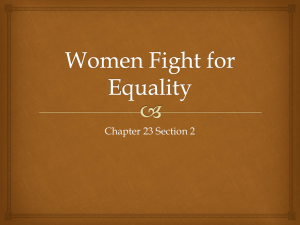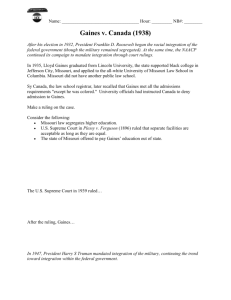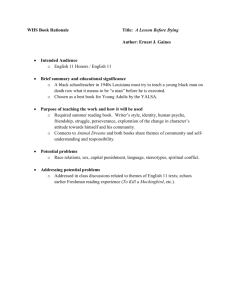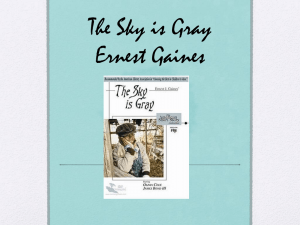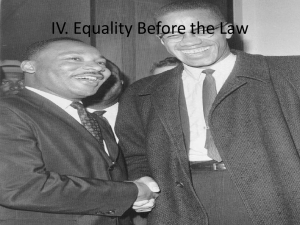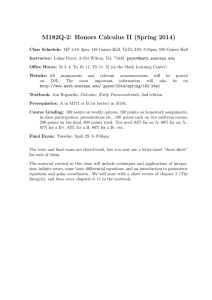Knowledge Level Modeling of Agents, ... and Technologies
advertisement
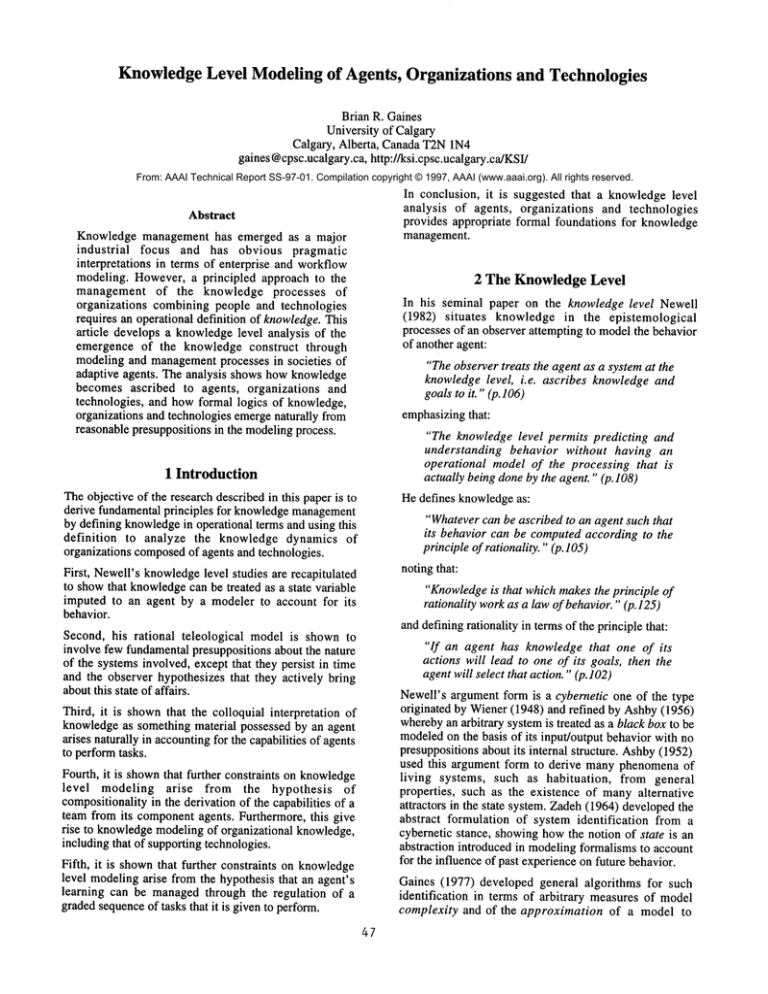
Knowledge Level Modeling of Agents,
Organizations
and Technologies
Brian R. Gaines
University of Calgary
Calgary, Alberta, Canada T2N1N4
gaines @cpsc.ucalgary.ca,http://ksi.cpsc.ucalgary.ca/KSI/
From: AAAI Technical Report SS-97-01. Compilation copyright © 1997, AAAI (www.aaai.org). All rights reserved.
In conclusion, it is suggested that a knowledge level
analysis of agents, organizations and technologies
provides appropriate formal foundations for knowledge
management.
Abstract
Knowledge management has emerged as a major
industrial
focus and has obvious pragmatic
interpretations in terms of enterprise and workflow
modeling. However, a principled approach to the
management of the knowledge processes
of
organizations combining people and technologies
requires an operational definition of knowledge. This
article develops a knowledgelevel analysis of the
emergence of the knowledge construct through
modeling and managementprocesses in societies of
adaptive agents. The analysis shows how knowledge
becomes ascribed to agents, organizations and
technologies, and how formal logics of knowledge,
organizations and technologies emergenaturally from
reasonable presuppositions in the modelingprocess.
2 The KnowledgeLevel
In his seminal paper on the knowledge level Newell
(1982) situates knowledge in the epistemological
processes of an observer attempting to modelthe behavior
of another agent:
"The observer treats the agent as a system at the
knowledge level, i.e. ascribes knowledge and
goals to it." (p.106)
emphasizingthat:
"The knowledge level permits predicting and
understanding behavior without having an
operational model of the processing that is
actually being done by the agent." (p.108)
1 Introduction
The objective of the research described in this paper is to
derive fundamental principles for knowledgemanagement
by defining knowledgein operational terms and using this
definition
to analyze the knowledge dynamics of
organizations composedof agents and technologies.
He defines knowledgeas:
First, Newell’s knowledgelevel studies are recapitulated
to showthat knowledgecan be treated as a state variable
imputed to an agent by a modeler to account for its
behavior.
noting that:
"Whatevercan be ascribed to an agent such that
its behavior can be computedaccording to the
principle of rationality." (p. 105)
"Knowledgeis that which makes the principle of
rationality workas a law of behavior." (p. 125)
and defining rationality in terms of the principle that:
Second, his rational teleological model is shown to
involve few fundamentalpresuppositions about the nature
of the systems involved, except that they persist in time
and the observer hypothesizes that they actively bring
aboutthis state of affairs.
"If an agent has knowledge that one of its
actions will lead to one of its goals, then the
agent will select that action." (p. 102)
Third, it is shownthat the colloquial interpretation of
knowledgeas something material possessed by an agent
arises naturally in accountingfor the capabilities of agents
to performtasks.
Fourth, it is shownthat further constraints on knowledge
level modeling arise from the hypothesis
of
compositionality in the derivation of the capabilities of a
team from its componentagents. Furthermore, this give
rise to knowledgemodelingof organizational knowledge,
including that of supporting technologies.
Fifth, it is shownthat further constraints on knowledge
level modelingarise from the hypothesis that an agent’s
learning can be managed through the regulation of a
gradedsequenceof tasks that it is given to perform.
47
Newell’s argument form is a cybernetic one of the type
originated by Wiener (1948) and refined by Ashby(1956)
wherebyan arbitrary systemis treated as a black box to be
modeledon the basis of its input/output behavior with no
presuppositions about its internal structure. Ashby(1952)
used this argument form to derive many phenomena of
living systems, such as habituation,
from general
properties, such as the existence of manyalternative
attractors in the state system. Zadeh(1964) developedthe
abstract formulation of system identification from a
cybernetic stance, showinghowthe notion of state is an
abstraction introduced in modelingformalisms to account
for the influence of past experienceon future behavior.
Gaines (1977) developed general algorithms for such
identification in terms of arbitrary measures of model
complexity and of the approximation of a model to
observed behavior, and showedthat appropriate measures
led to optimal identification
of deterministic and
stochastic automata from their behavior. He emphasizes
the formal arbitrariness of the presuppositions underlying
a modeling schema, and shows that inappropriate
presuppositions lead to indefinitely complex models
(Gaines, 1976).
What characterizes living systems are the recursive
activities of self-replication underlyingtheir persistence,
that they actively and continually create the conditions for
their persistence. Maturana(1975) has proposed that this
is the fundamental distinction between living and nonliving systems. Autopoietic systems:
"are systems that are defined as unities as
networks of production of components that (1)
recursively, through their interactions, generate
and realize the network that produces them; and
(2) constitute in the spacein whichthey exist, the
boundaries of this network as components that
participate in the realization of the network...a
living system is an autopoietic system in physical
space." (Maturana, 1981)
In the light of these analyses, Newell’s argumentsmaybe
seen as stating that knowledgeis a state variable imputed
by a modelerin order to account for its behavior, and that
the appropriate presuppositions for modelingan agent are
those of rational teleology, that it has goals and acts to
achieve them. Twofundamental questions arise about
Newell’s framework for knowledge, one reaching
backwards to the justification
of modeling behavior
teleologically in terms of goals and their rational
achievement, and the other reaching forwards to the
nature of the knowledgestate space that an observer will
generate, its detailed qualitative and quantitative
characteristics.
However, there is no notion of goals or knowledge in
Maturana’s definition, and no ascription of intentions to
living systems. A reactive persistent system in itself has
no goals or intentions. It reacts to its environmentthrough
mechanismsthat tend to maintain its persistence despite
changes in its environment. An external observer may
model this behavior as goal-directed because that
provides a simple predictive explanation. That is, if an
autopoietic system when disturbed, regardless of what
state it is triggered into, seemsto return to its original
state, it is naturally modeled as goal-seeking. If the
system’s environment happens to contain other systems
like itself and the system’s activities include observation
and modeling, it may model the other systems as goaldirected, and then by analogy come to model itself as
goal-directed. This is a natural outcomeof autopoiesis in
a social environment.
The next section briefly examines the preconditions for
rational teleological models to be effective, and the
remainder of the paper develops in depth the structure of
knowledgemodelsthat will arise in a society of agents.
2 Emergenceof Rational Teleological Models
One way of analyzing the foundations of rational
teleological models is to assume that they have none-that the modeling of other agents in terms of goals and
knowledgeis justified to the extent that it works--a
pragmatic argument of the form developed by Peirce and
James (Ayer, 1968). This assumption is that of Dennett’s
(1987) intentional stance, and it is in accordancewith the
basic theory of modeling, the Popperian position that our
presuppositions in modelingare but conjectures subject to
refutation if we are not satisfied with the results of using
them(Popper, 1963). Modelingtheory tells us that if the
intentional stance was not appropriate to modelinghuman
agents then it would lead to complex models with poor
predictive power and we would find it more useful to
adopt someother stance.
As well as not reading too much into models of
autopoietic systems, it is important to note that we can
ascribe very little to their existence. A chaotic universe
has a probability of producing any system including
autopoietic systems. Once such systems exist and are
modeled properties emerge (Sharif, 1978). As Peirce
remarks:
"Law begets law; and chance begets
chance...the first germ of law was an entity
whichitself arose by chance, that is as a First."
(Peirce, 1898)
However,it is useful to examine some simple systemic
characteristics of agents that would justify the use of
rational teleological modelsif only to illustrate howfew
presuppositions are necessary for the model to be useful
(Gaines, 1994). The most fundamental properties which
we imputeto any system are its existence and persistence
over time. A system is identifiable as not having existed
before sometime, of definitely existing after somelater
time, of persisting in existence until somelater time, and
of not existing again after somelater time. This coming
into existence, persisting for while, and going out of
existence again is a commonproperty of all systems. It
applies to both living and non-living systems, and in
living systemsit applies at all levels fromcell to species.
Jantsch (1980) and Prigogine (1984) have developed
detailed models of howorganization emerges from chaos.
Gould (1989) has analyzed the fossil record and modeled
the genesis and extinction of a wide variety of species as
low probability randomevents. Monod(1972) has given
biochemical model of life as an improbable phenomena
that, once it exists, follows deterministic laws. Whena
living systemcomesinto existence it acts to persist, but,
from the systemic perspective advancedby Maturana, this
is the definitional property by which we recognize its
existence as a living system, not an additional property
going beyondactive persistence.
48
manydisadvantages as advantages, and maybe seen as of
negative value to the survival of the humanspecies.
Barrow and Tipler (1986) have analyzed the remarkably
narrow physical conditions under which life as we know
it can exist, and when one examines the mechanismsby
which a living organism narrows these conditions even
further in order to persist it is natural to ascribe purposeto
its activity. For example, Cannon (1932), terms such
activity homeostasis and part of The Wisdomof the Body
and Ashby(1952) in analyzing homeostasis as part of his
Design for a Brain modelsit as a goal-directed process.
However, he also shows how such apparently goaldirected behavior arises in any system with manystates of
equilibrium. The utility of an intentional stance stems
from simple systemic considerations, and one has to be
careful in reifying the notion of agencyto realize that the
additional assumption of the existence of some reified
’agent’ is also a matter of utility, not of existential proof
or necessity.
2.1 Emergence in Knowledge Management
This conceptual framework, emphasizing opportunistic
rather than goal-directed behavior, is already a major
componentof the knowledgemanagementliterature. One
of Bridges’ recommendationsin ManagingTransitions is
to Let Goof Outcomes:
"we cannot ultimately control outcomes, and
whenwe try to, we either alienate others or drive
ourselves crazy." (Bridges, 1991)
Johanssonand Nonakause related criteria to differentiate
Western and Japanese companies in their approach to
marketing:
"Whereas strategic
planning in the West
typically cascades down in logical steps from
broad mission statements to more specific
objectives to the enumeration of tasks, the
assignmentof responsibilities and the fixing of a
time schedule, the Japaneseapproachis fuzzier.
The intuitive incrementalism of the Japanese
means essentially experience-based learning, a
natural or ’organic’ process." (Johansson and
Nonaka, 1996)
In Ashby’s day a system that reacted to its environment
by acting until it arrived in a new modeof equilibrium
wouldbe seen as not only counter-acting the effects of the
environment but also arriving at some state that was
determinedby those effects, that is, apparently targeted
upon them. Nowadays,with the realization that strange
attractors are prevalent in all forms of physical system
(Ruelle, 1989), and particularly in biological processes
and their higher-order manifestations such as brains
(Basar, 1990~societies (Dendrinos and Sonis, 1990)
cultural phenomena(Hayles, 1991), it wouldbe realized
that the final state maybe one of very manythat have the
equilibrating effect but is neither determined by the
effects of the environmentnor targeted uponthem.
Barabba’s (1995) introductory chapter in Meeting of the
Minds is entitled The Late Great Age of Commandand
Control and critiques the normative approach to business
based on predefined objectives rather than an adaptive
one based on learning from the market place, the
organization’s natural environment.
In particular, the definition of fitness of a species in
evolutionary terms is merely a restatement of the species’
persistence in terms of the environment in which it
persists. As Ollasonargues:
There is an interesting parallel on this emphasis on
openness to experience in Gadamer’sdiscussion of what
it is to be an expert:
"Biologists use the concept of fitness as the
explanation of the truly inexplicable. The
process of evolution is exactly what the
etymologyof the wordimplies: it is an unfolding,
an indeterminate, and in principle, inexplicable
unfolding. (Ollason, 1991)
"The nature of experience is conceived in terms
of that which goes beyondit; for experience can
never be science. It is in absolute antithesis to
knowledge and to that kind of instruction that
follows from general or theoretical knowledge.
The truth of experience always contains an
orientation towards new experience. That is why
a person who is called ’expert’ has becomesuch
not only through experiences, but is also open to
new experiences.
The perfection
of his
experience, the perfect form of what we call
’expert’, does not consist in the fact that
someone already knows everything and knows
better than anyone else. Rather, the expert
person proves to be, on the contrary, someone
who is radically undogmatic; who, because of
the many experiences he has had and the
knowledge he draws from them is particularly
equipped to have new experiences and learn
from them." (Gadamer, 1972)
A species is fit to exist in an environment in which it
happens to persist. As noted in the previous paragraph,
this does not meanit was targeted on that environmentor
that there is a determinate relation betweenthe nature of
the environment and the species that happens to have
evolved. The environmentacts as a filter of species and
those that persist are fit to survive. There are no
teleological implications, and this model does not give
’survival-directed’ behavior any greater probability of
leading to persistence than any other behavior. Gould
(1989) details the random phenomena that have made
particular species fit to persist for a while in the fossil
record. Bickerton (1990) argues that there is no evidence
for what we deemto be high-level humantraits to have
survival value--intelligence and languagehave at least as
49
One can paraphrase the knowledge management texts
cited aboveas stating that an ’expert organization’ is one
that satisfies Gadamer’snotion of what it is to be an
expert person. However,it is important to note that he
contrasts knowledge and expertise. While a rational
teleological model may naturally emerge when modeling
a persistent agent as actively involved in ensuring its
persistence, the knowledgeimputedis a by-product of the
modeling process not the cause of the persistence.
Modeling the openness and adaptivity of expertise
involves multiple levels of modeling,and the observer has
to introduce notions of ’meta-knowledge’ or ’deep
knowledge’in order to account for the processes whereby
the knowledgeimputedto account for specific short-term
behavior changes through experience.
2.2 Summaryand Implications
In conclusion, in adopting an intentional stance one is
selecting a modeling schema for its simplicity,
convenienceand utility. Newell’s notions of rationality,
goals and knowledgehave no epistemological content and
are circularly derivable from one another as definitions of
what it is to adopt an intentional stance. The knowledge
level can be reified only through our first being satisfied
that it has predictive capabilities, and then through our
further presupposing that there must be some real
phenomenon
out there that makesthat prediction possible.
Wehave to be very careful in testing both of these
conditions: the reflexivity of social interactions means
that changes in our behavior based on assumptions about
another’s intentions maylead to contingent behavior on
the part of the other (Levis, 1977) giving rise to apparent
predictive validity; and the predictive capabilities of a
cybernetic model of a black box place very few
constraints on what structure actually exists within the
box.
Wealso have to distinguish those aspects of an agent’s
behavior that an observer is attempting to model. For
example,modelingthe agent’s current skills, it capability
to use those skills in specific contexts such as in a team,
and its capabilities to learn to improveits skills, are three
different modeling requirements that place different
constraints on knowledgelevel modeling. The following
three sections investigates each of these requirements in
turn.
3 Knowledge as an Imputed State
essentially a product of a social process. Onecan ask the
question "why should it be valuable to model another
agent" and cometo the conclusion that the humanspecies
is characterized by its social dependencies, the divisions
of labor whereby many of the goals of one agent are
satisfied through the behaviors of others. In these
circumstances
one agent will model another in
instrumentalterms, in terms of its capabilities to carry out
tasks that will lead to the modelingagent’s goals being
satisfied--and, vice versa, the other agent will modelthe
first in a reciprocalfashion.
Considera set of agents, A, and a set of tasks, T, such that
it is possible to decide for each agent, a~ A whetherit can
carry out a task t~ T. Assume,without loss of generality,
that this is a binary decision in that performance at
different levels is assumedto define different tasks, and
that wecan write a o t for the truth value that agent a can
carry out task t. Wecan then characterize an agent’s
competence,C(a), by the set of tasks which it can carry
out:
C(a) -- {t ~ T: a o t}
(1)
If one agent knows C(a) for another agent, a, then
knowsits competencein terms of the tasks it can carry
out and can plan to manage its goals by allocating
appropriate tasks to the other agent.
However, keeping track of the competencies of relevant
agents in terms of extensive sets of tasks for which they
are competentis inefficient both in knowledgeacquisition
and storage if there are manydependenciesbetween tasks
such that the capability to carry out one task is a good
predictor of the capability to carry out another. A partial
order of difficulty on tasks, >, maybe defined such that
the capability to carry out a task of a given difficulty
indicates the capability to carry out tasks of lesser
difficulty in the partial order:
Vt, u ~ T,t > u = Va ~ A, a o t ---> a o u
(2)
If, there is a rich partial order on tasks independentof
agents then it becomesreasonable to attempt to represent
the partial order as one embeddedin the free lattice
generated by some set, K, which we shall term
knowledge. Since the free lattice generated by a set of
cardinality,
n, has 2n distinct members, there is
potentially an exponential decrease in the amount of
information to acquire and store about an agent if it is
characterized in terms of its set of knowledgerather than
the set of tasks it can perform. This decrease will be
realized to the extent that the embedding of the task
dependencies in a free lattice
involves tasks
correspondingto all elementsof the lattice.
Variable
The previous section having warned against reading too
muchinto knowledgelevel models, the current one will
build such a model based on a sequence of plausible
assumptions largely concerned with cognitive
ergonomics--of building models that require as little
effort to develop as possible. The starting point is
Newell’s notion that the knowledgelevel originates in one
agent attempting to model another, and hence is
Thus, we posit a set of knowledge,K, such that a task, t,
is characterized by the set of knowledge,K(t), required
carry it out, and the order relation between tasks
corresponds to subset inclusion of knowledge:
5O
(3)
¯
An agent, a, is characterized by the knowledge it
possesses, K(a), and this determines its competence
terms of tasks:
P2: Thereis a rich order relationship of difficulty on
tasks that is reasonably independent of particular
agents.
¯
P3: Knowledge is not just possessed but can be
generated in a principled fashion from other
knowledge.
Vt, u ~ T, t > u =- K(t) D K(u)
C(a) -- {t ~ T: K(a) K(t)}
(4)
The developmentto this stage parallels that of knowledge
spaces as defined by Falmagne, Koppen, Villano,
Doignonand Johannesen (1990), and applied by them
testing a student’s knowledge. However, the movefrom
an extensional specification in terms of tasks to an
extensional specification in terms of knowledge is
inadequate to account for situations where the capability
to carry out one task mayindicate the capability to carry
out an infinite numberof lesser tasks. Extensionally, this
involves indexing the lesser tasks as involving an infinite
set of knowledge,but, as Newell(1982) notes it is better
represented by a schemain which knowledgeis generated
from knowledge.
If x is a subset of knowledgethen G(x) maybe defined
the subset which can be generated from it subject to the
obviousconstraints that:--the original knowledgeis retained:
x C K ~ x c G(x)
(5)
c
What the development does not do is characterize the
nature of knowledge,other than as an arbitrary index set
used in modeling. It wouldbe reasonable to suppose that
our actual definitions of knowledge elements would be
closely related to our definitions of, and terminologyfor,
tasks--for example, that someone capable of adding
numbers might be said to have "knowledgeof addition."
However, too close a link to tasks would reduce the
benefits of representing capabilities through subsets of
knowledge rather than subsets of tasks, and hence we
would expect an attempt to characterize knowledgein a
way that abstracts away from tasks and looks for more
general knowledge elements that underlie a range of
tasks.
The following sections develop a theory of the
managementof agents’ knowledge processes which gives
further insights into the properties of a useful
characterization of the knowledgelevel, particularly the
granularity of knowledge.
--all of the knowledgethat can be generated is included:
x c K ~ G(G(x))
These are strong presuppositions but ones that seem to
work reasonably well in characterizing humanagents-we are acutely aware of the exceptions and treat them as
anomalies.
(6)
--additional knowledgegenerates additional knowledge:
x c y C K ~ G(x) c G(y)
(7)
4 Organizational
Tarski (1930) noted that the consequenceoperator of any
deductive system has these properties, and W6jcicki
(1988) has used it conversely to characterize any closure
operator satisfying (5) through (6) as logic. AsRasiowa
and Sikorski (1970) remark:
The previous section constrains knowledgelevel models
to be predictive of individual agent’s performance of
tasks. However, agents generally work together in
organizations and it is reasonable to supposethat a further
constraint upon such models is that they should be
predictive of the aggregate capabilities
of agents
operating in organizations and in conjunction with
technological support.
"the consequence operation in a formalized
~
theory T should also be called the logic of ~1
that is, every generatordefines a formal logic.
The development of this section has arrived at a
characterization of the knowledgelevel that corresponds
to the folk psychologynotion that agents can be modeled
as possessing something termed knowledge, and the
cognitive science notion that the capability to generate
knowledge from knowledge corresponds to a formal
deductive logic. Whatpresuppositions have been involved
in this development?
¯
Knowledge
PI: Agents have a reasonably stable competencesuch
that it is well-defined whetheran agent can carry out
a task.
A useful perspective
from which to examine
organizations is a collective stance (Gaines, 1994)
which humanity is viewed as a single adaptive agent
recursively partitioned in space and time into sub-systems
that are similar to the whole. In humanterms, these parts
include societies, organizations, groups, individuals, roles,
and neurological functions (Gaines, 1987).
It is reasonable to add a further constraint
generative function G, that:-
to the
-- an agent’s knowledgeincludes that of its components:
a ~ b --~ G(K(a)) c G(K(b))
51
(8)
A stronger constraint maybe stated as a compositional
hypothesis:
¯ P4: The knowledge of a compound agent can be
derived from the knowledgeof its parts and their
organization.
That is, the organizational knowledgeis the union of the
enhancements that each agent contributes
to the
organization.
5 Learning
In practice, this maybe an irrefutable hypothesis whereby
weassumethat if such a derivation is incorrect it is due to
inadequate characterization of the agents’ knowledgeor
of the way in which they are organized. For example, if
we put together a team of people with apparently
adequate knowledgebetween them to perform a task, and
they can not do so, then we are likely to say that they
lacked the skills to worktogether or that the situation did
not allow them to. That is, we ascribe the failure of
compositionality to a failure to have properly modeledthe
knowledgerequired or to an inadequate organization. We
reevaluate the knowledgemodelof the agents rather than
ascribe the problemto a failure of the compositionality
hypothesis, thus makingit an axiomatic constraint upon
the notion of a complete knowledgemodel.
Presupposition P1 in Section 3, that agents have
reasonably stable competenceis in contradiction to our
expectations that agents will improve their competence
with experience. In particular, it is antithetical to
Gadamer’s notion of an expert as one who learns from
experience.
To take into account learning, one can weakenP1 to the
presupposition that agents do not lose competence:
¯ PI’: Agents have a monotonically increasing
competencesuch that if an agent can carry out a task
it will alwaysbe able to carry out that task.
and treat C(a) as lower boundon an agent’s competence.
The knowledgelevel analysis of Section 3 then follows
but with the set of knowledgecharacterizing the agent’s
state being a lower boundon the agent’s knowledge.
One interesting possibility is to extend the notion of
knowledge to the organizational aspects of a compound
agent by assessing the difference between the knowledge
of an agent and that of its components,and ascribing this
to its organization:O(a) =- G(K(a)) - U
The analysis of Section 4 of the enhancement brought
about by some supporting system maythen be applied to
the state of the agent: before support, with support, and
after support. The after support enhancementdefines the
learning brought about by the experience of having the
support. For example, what tasks one can perform before
reading a book, while having access to it, and after having
readit.
(9)
x~a
That is, O(a) is the additional knowledgeresulting from
the organization of the agents into an organization.
This analysis provides a basis for modelingvarious forms
of knowledgetransfer mechanisms,differentiating them
from knowledgesupport systems (Gaines, 1990). It also
making it clear that what at one time was termed
’expertise transfer’ is better termed’knowledgetransfer’,
and that the ’transfer’ is not explicit, but rather a wayof
describing and agent’s changeof state.
4.1 Impact of Technology on Knowledge
The measurementof the impact of organizing agents in
equation (9) may be generalized to apply to any
contextual variables that impact the capabilities of an
agent or agents. For example, an agent, a, together with a
book, a tool, or computersupport, maybe regarded as an
enhanced agent a’, and one may measure the
enhancementat the knowledgelevel as:
E(a,a’)
=- G(K(a’ )) - G(K(a))
It is tempting to apply knowledgelevel analysis to the
learning capabilities
of an agent through the
presupposition:-
(10)
That is, E(a,a’) is the additional knowledgeresulting from
the book, tool, computer support or other contextual
variables.
P5: The capability of an agent to becomecompetent
to carry out a task can be predicted from its learning
knowledge.
This analysis maybe applied to give an instrumental view
of the effect of one agent collaborating with another. For
example, that when I help you then I am an instrument
contributing to your capability. This is the form of
analysis we use to explicate the notion of a coach.
The notion of meta-knowledge that is predictive of an
agent’s capabilities to acquire knowledgeis consistent
with the educational literature on study skills and learning
to learn (Novak and Gowin, 1984; Borenstein and
Radman,1985). However, a knowledgelevel analysis of
learning is incomplete in that it cannot account for many
of the phenomenaof learning and training such as the
probabilistic nature of trial and error learning and the
managementof training through performance feedback
with no model of an agent’s exact knowledge state
(Gaines, 1972a,b).
One can derive a relationship between equations (9) and
(10):
O(a)
= ~E(x,a)
(11)
XEa
52
The analysis of organization as agents requires existing
knowledge level theories to be extended to take into
account the relations between an agent and its parts,
including other agents and technologies. It also requires
the theories to be extended to take into account the
uncertainties in modelsand the learning capabilities of
agents. This article provides a preliminary account of
such extensions as a first step towards principled
foundations for knowledge management.
5.1 Uncertainty at the KnowledgeLevel
There is a fundamentaluncertainty at the knowledgelevel
in distinguishing between phenomenaascribable to the
incompleteness of a model of an agent and those
ascribable to the agent’s learning. If the agent is in the
situation of undertaking a newtask and proves capable of
performingit then we can ascribe this either to the agent’s
existing knowledgethat had not been modeled or to the
agent having acquired the knowledge in attempting to
performthe task.
Acknowledgments
Financial assistance for this workhas been madeavailable
by the Natural Sciences and Engineering Research
Council of Canada
As already noted, similar considerations apply to
predictions of the capabilities of a team from modelsof
the knowledge of the agents forming the team. A full
treatment of the knowledgelevel has to take into account
that the modelingis subject to intrinsic uncertainties and
that the modeled system is subject to change with
experience.
References
Ashby, W.R. (1952). Design for a Brain. London, UK,
Chapman& Hall.
Ashby, W.R. (1956). An Introduction to Cybernetics.
London, UK, Chapman& Hall.
Ayer, A.J. (1968). The Origins of Pragmatism.London,
MacMillan.
Barabba, V.P. (1995). Meeting of the Minds: Creating
the Market-BasedEnterprise. Boston, MA,Harvard
Business School Press.
Barrow, J.D. and Tipler, F.J. (1986). The Anthropic
CosmologicalPrinciple. Oxford, Clarendon Press.
Basar, E., Ed. (1990). Chaosin Brain Function. Berlin,
Springer.
Bickerton, D. (1990). Languageand Species. Chicago,
University of ChicagoPress.
Borenstein, S. and Radman, Z.A. (1985). Learning to
Learn: An Approach to Study Skills. Dubuque,
Kendall/Hunt.
Bridges, W. (1991). ManagingTransitions: Makingthe
Most of Change. Reading, Massachusetts, AddisonWesley.
Cannon, W.B. (1932). The Wisdom of the Body.
London,
Dendrinos, D.S. and Sonis, M. (1990). Chaosand SocioSpatial Dynamics.Berlin, Springer.
Dennett, D.C. (1987). The Intentional Stance. MIT
Press, Cambridge,Massachusetts.
Falmagne,J.-C., Koppen,M., Villano, M., Doignon, J.-P.
and Johannesen, L. (1990). Introduction to knowledge
spaces: how to build, test and search them.
Psychological Review97(2) 201-224.
Gadamer, H.G. (1972). Wahrheit und Mcthode.
Ttibingen, Mohr.
Gaines, B.R. (1972a). The learning of perceptual-motor
skills by men and machines and its relationship to
training. Instructional Science 1(3) 263-312.
Gaines, B.R. (1972b). Training, stability and control.
Instructional Science 3(2) 151-176.
Gaines, B.R. (1976). Onthe complexity of causal models.
IEEE Transactions
on Systems,
Man &
Cybernetics SMC-6(1)56-59.
This uncertainty leads to a knowledge management
perspective wherebythe capabilities of an agent, such as
an organization, must be managedas part of the modeling
process. Knowledgemodeling is an active process of
creating a model through action as muchas it is one of
fitting a modelthrough observation.
The practical question then becomes one of how good a
model needs to be for effective management.That is, we
are not concerned with completeness of models but only
their adequacy for particular purposes. For example, a
related article showsthat the optimization of learning to
accelerate a sigmoidal learning curve to becomea linear
one can be managedwith surprisingly weakmodels of the
knowledgestates of the agents involved (Gaines, 1996).
6 Conclusions
An operational
definition
of knowledge has been
developed through a knowledge level analysis of the
emergence of the knowledgeconstruct through modeling
and management
processes in societies of adaptive agents.
The analysis shows how knowledge becomes ascribed to
agents, organizations and technologies, and howformal
logics of knowledge, organizations and technologies
emerge naturally from reasonable presuppositions in the
modelingprocess.
Intrinsic uncertainties in our modelsand the capabilities
of agents to learn imply that knowledgemodelinghas to
be an active process of knowledge management. Weare
as much creating a model through action as fitting a
modelthrough observation.
Whathas happenedin recent years is the recognition that
processes of organizational management, including
personnel selection and placement, career development,
team building, and so on, may all be subsumedwithin a
single framework by knowledge level analysis of the
organization as an agent with certain capabilities.
53
Newell, A. (1982). The knowledge Level. Artificial
Intelligence 18(1) 87-127.
Novak, J.D. and Gowin, D.B. (1984). Learning How
Learn. NewYork, CambridgeUniversity Press.
Ollason, J.G. (1991). Whatis this stuff called fitness?
Biology and Philosophy 6(1) 81-92.
Peirce, C.S. (1898). Reasoningand the Logic of Things.
Cambridge,Massachusetts, Harvard University Press.
Popper, K.R. (1963). Conjectures and Refutations: The
Growth of Scientific Knowledge. London, Roufledge
& Kegan Paul.
Prigogine, I. (1984). Order out of Chaos. Toronto,
Bantam.
Rasiowa, H. and Sikorski, R. (1970). The Mathematics
of Metamathematics. Warsaw, PWN.
Ruelle, D (1989). Chaotic Evolution and Strange
Attractors. Cambridge, UK, Cambridge University
Press.
Sharif, N. (1978). Anintroduction to modeling.Sharif,
and Adulbhan, P., Ed. Systems Modeling for
Decision Making. pp.l-21. Bangkok, Asian Institute
of Technology(distributed by PergamonPress).
Tarski, A. (1930). Fundamentale Begriffe der
Methodologie der deduktiven Wissenschaften I.
Monatahefte fiir Mathematik und Physik 37 361404.
Wiener, N. (1948). Cybernetics
or Control and
Communication
in Animal and Machine.
Cambridge,Massachusetts, MITPress.
W6jcicki, R. (1988). Theory of Logical Calculi.
Dordrecht, Kluwer.
Zadeh, L.A. (1964). The concept of state in system
theory. Mesarovic, M.D., Ed. Views on General
Systems Theory: Proceedings of the Second
Systems Symposium at Case Institute
of
Technology. NewYork, John Wiley.
Gaines, B.R. (1977). Systemidentification, approximation
and complexity. International Journal of General
Systems 2(3) 241-258.
Gaines, B.R. (1987). Positive feedback processes
underlying functional differentiation. Caudhill, M. and
Butler,
C., Ed. Proceedings of IEEE First
International
Conference on Neural Networks.
Vol.2. pp.387-394.
Gaines, B.R. (1990). Knowledge support systems.
Knowledge-BasedSystems 3(3) 192-203.
Gaines, B.R. (1994). The collective stance in modeling
expertise in individuals
and organizations.
International Journal of Expert Systems 7(1) 21-51.
Gaines, B.R. (1996). Adaptive interactions in societies
agents. Workshopon Intelligent Adaptive Agents.
pp.4-1O. Menlo Park, CA, AAAI.
Gould, S.J. (1989). Wonderful Life: The Burgess Shale
and the Nature of History. NewYork, Norton.
Hayles, N.K., Ed. (1991). Chaos and Order: Complex
Dyanmics in Literature
and Science. Chicago,
University of ChicagoPress.
Jantsch, E. (1980). The Self-Organizing Universe.
Oxford, PergamonPress.
Johansson, J.K. and Nonaka, I. (1996). Relentless: The
Japanese
Way of Marketing.
New York,
HarperBusiness.
Levis, A.J. (1977). The formal theory of behavior.
Journal of Social Psychiatry 23(2)
Maturana, H.R. (1975). The organization of the living:
theory of the living organization. International
Journal Man-MachineStudies 7(3) 313-332.
Maturana, H.R. (1981). Autopoiesis. Zeleny, M., Ed.
Autopoiesis: A Theory of Living Organization.
pp.21-33. North Holland, NewYork.
Monod, J (1972). Chance and Necessity. London,
Collins.
54
